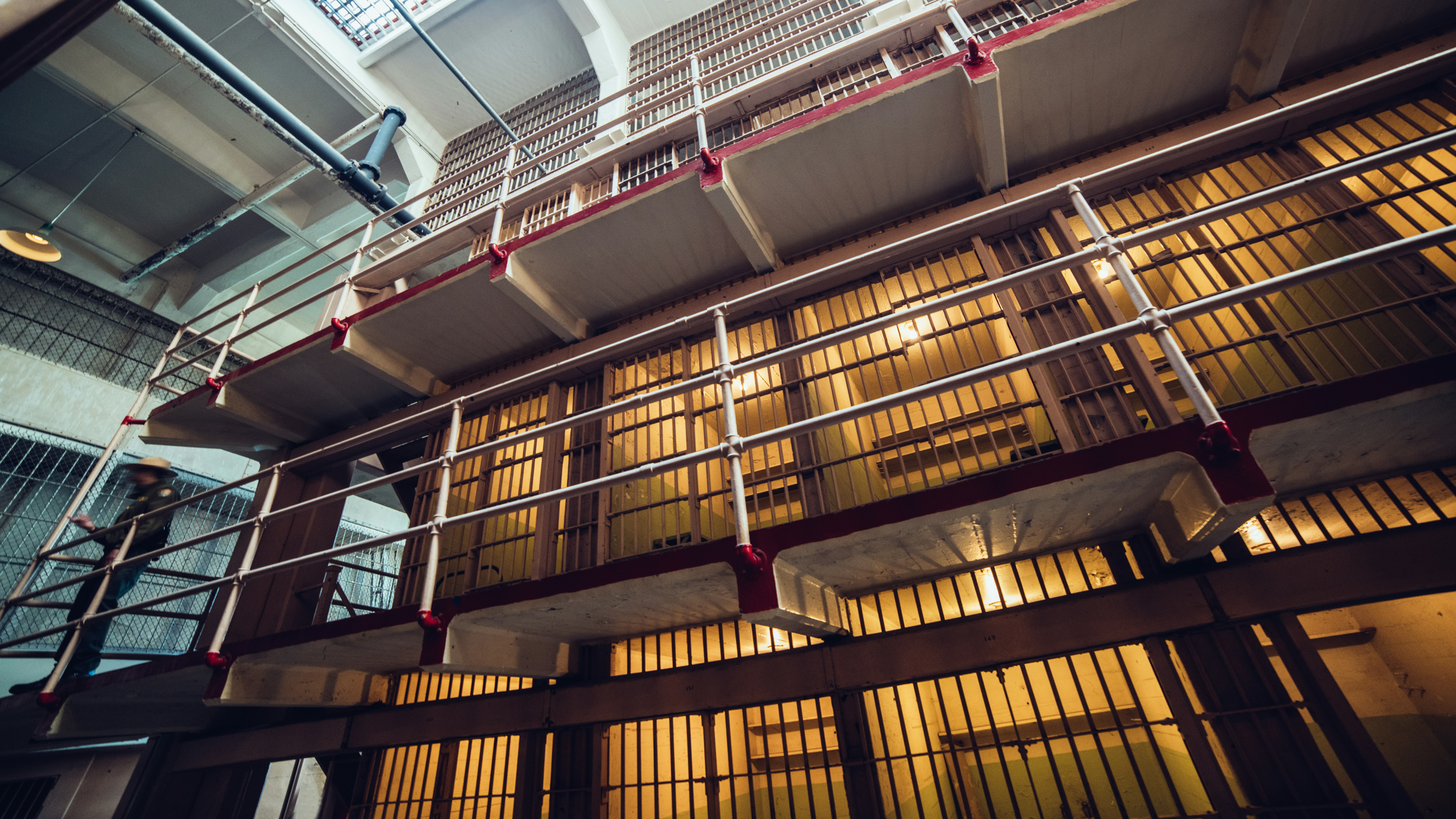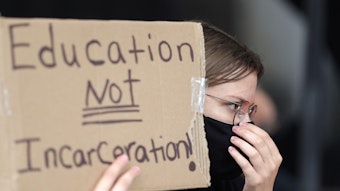Reimagining Safety and Justice

Incarceration in the United States has reached crisis levels. How did we get here, and what can we do about it?
The United States has the world’s highest incarceration rate (629 per every 100,000 residents) as well as the world’s largest number of people behind bars.
“This has not always been the case. Nor is it a neatly partisan issue,” says Tomiko Brown-Nagin, dean of Harvard Radcliffe Institute, who is also Daniel P. S. Paul Professor of Constitutional Law and a professor of history at Harvard University. “A consensus of scholars, activists, and policymakers across the political spectrum regards this as an urgent problem, and one that warrants decisive action. Fundamentally, this is a national and a moral crisis.”
In her book From the War on Poverty to the War on Crime: The Making of Mass Incarceration in America (Harvard University Press, 2017), the historian Elizabeth Hinton documented the legal machinations that turned the United States into a prison nation, or the intersecting mass of punitive structures—including foster care and immigrant detention systems, punitive policies such as welfare reform, prisons, and jails.
In the century between the end of the Civil War in 1865 and then-President Lyndon B. Johnson’s 1965 call for a War on Crime, the United States sent a total of 184,901 people to state and federal prisons.
“Ever since Lyndon Johnson called for a War on Crime some 50 years ago, policing, surveillance, and confinement have served as the primary response to all socioeconomic and public health issues like poverty and mental health,” Hinton said in her keynote address at the University of Pennsylvania Carey Law School.
Johnson is best known for signing the 1965 Voting Rights Act into law. But that same year, he also signed the Law Enforcement Assistance Act, which administered $30 million (or $223 million in today’s dollars) in federal grants to local and state law enforcement for militarized policing. During the next two decades, the United States sent 251,107 people to prison.
That was only the start. In 1982, Ronald Reagan declared drugs to be a threat to national security, launching the present-day War on Drugs. His attorney general Ed Meese advocated eliminating the Miranda warning, which reminds people of their right to a lawyer during police questioning.
The build-up of the United States as a prison nation was bipartisan, as both Republicans and Democrats advocated tough-on-crime legislation throughout the 1980s and 1990s. These laws enabled prosecutors to charge minor participants in drug transactions with major felonies and required judges to impose lengthier prison sentences, including mandatory life sentences, for an increasing number of convictions. Then-Representative Newt Gingrich, for instance, made imprisoning more people and curtailing parole the centerpiece of his conservative “Contract with America.”

On September 27, 1994, then–House Minority Whip Newt Gingrich (R-Ga) addressed Republican congressional candidates on Capitol Hill during a rally where they pledged a new "Contract with America." Photo by AP Photo/John Duricka
In 1994, then-Senator Joe Biden authored the 1994 Violent Crime Control and Law Enforcement Act (or the 1994 Crime Bill), which provided funding for 100,000 new police officers, earmarked $9.7 billion for new prison beds, and imposed lengthier prison sentences. It was roundly supported by both Democrats and Republicans.
On the state level, lawmakers passed similar tough-on-crime bills. The result was an explosion of imprisonment across the country—from approximately half a million people behind bars (or 310 of every 100,000 residents) in 1980 to 2.1 million (or 810 of every 100,000 residents) in 2019.
These laws disproportionately targeted people of color, particularly African Americans. In 2019, Black people were imprisoned at a rate more than five times that of white people, and Latinx people at twice the rate of their white counterparts.[2]
“The foundation on which [mass incarceration] was built starts from the end of slavery,” says Andrea James, cofounder of the National Council for Incarcerated and Formerly Incarcerated Women and Girls. “The foundation is built on the oppression, continued control, and the use of labor of Black people in this country.”
Now, at least 4.9 million people are arrested and jailed each year. By the end of 2019, over 2.2 million people were in jails and prisons and another 4.5 million under some form of supervision. (Jails and prisons slowed admissions during COVID, decreasing to 1.8 million incarcerated in 2020, although those figures are now increasing.)
The United States spends nearly $85 billion each year on jails and prisons alone. “These are investments in a failed system steeped in racism and built on a foundation of intentional racism,” stated James.

Crime laws disproportionately targeted people of color, particularly African Americans. Graphic by Mel Rico/Harvard Radcliffe Institute
Proposing Solutions
For years, despite the financial and human costs, lawmakers shied away from proposals that might make them appear soft on crime.
Now, however, heightened attention, increased outrage, and the exorbitant price tag has propelled recent efforts at bipartisan criminal justice reform with seemingly unlikely partners. Some of these partners are the same conservative lawmakers—such as Gingrich, Meese, and Jeb Bush—who were responsible for building up the prison nation.
In December 2018, the First Step Act was signed into law. Supported by progressive and conservative organizations, including the American Civil Liberties Union (ACLU), the NAACP, ALEC (American Legislative Exchange Council), the Center for American Progress, Right on Crime, and the Koch Brothers, the First Step Act limited mandatory minimum sentences for low-level federal drug convictions, provided retroactive sentence reductions to people imprisoned under the 100 to 1 crack-cocaine disparity, and expanded rehabilitation programs in federal prisons. Another provision allows people in federal prisons to earn credits toward an early (although still supervised) release by completing prison rehabilitative programs.
The First Step Act applies only to those in federal prison who, as of 2019, composed 12 percent of the nation’s prison population. It does not extend to the more than one million people in state prisons.
Approximately 5,500 people have been released through the First Step Act. But the Bureau of Prisons, which operates federal prisons, also failed to apply credits for sentencing reductions or earlier releases to 60,000 people who completed the First Step programs.
Additionally, many remain ineligible for the Act’s program provisions. James noted that the Act automatically excludes people serving life sentences and noncitizens facing deportation. It also excludes people convicted of 72 offenses, including killing or attempting to kill a fetus, threatening the president or former president, computer fraud, damaging a pipeline facility, and escaping from or rioting in a prison.
This year, federal lawmakers are pushing again for more bipartisan criminal justice reform. Senators Dick Durbin (D-IL) and Chuck Grassley (R-IA) authored three bills, all of which have been approved by the Senate Judiciary Committee.
Although Black people are the largest racial group among federal prisoners, James notes that the Act—and current bipartisan legislation—fails to address the structural racism enabling police, prosecutors, and other legal actors to disproportionately criminalize and imprison Black people and people of color. Instead, she says, the Act “wipes [structural racism] out of the conversation.”
Finally, James also notes that many of the same organizations championing bipartisan reform also push legislation dismantling voting rights and blocked recent voting rights bills. “How can we think they have the right to be leading criminal justice reform when they’re invested in destroying our communities?” she asks.
Instead, James believes strongly that solutions must center those directly affected by violence, incarceration, and disenfranchisement.
Through the National Council and the Massachusetts-based Families for Justice as Healing, James and other formerly incarcerated advocates have been organizing to end female incarceration. Their efforts have included campaigns for clemency, or sentence reductions allowing earlier release. During the Obama presidency, the National Council embarked on a #FreeHer campaign demanding clemency for women serving life sentences for drug war convictions. Now, they are calling on President Joe Biden to commute the sentences of those released from prison to home confinement under the CARES Act and to grant clemency to 100 women still imprisoned under the decades-old laws he helped create.
On the state level, they have formed coalitions to stop a proposed new women’s prison, advocate for a five-year moratorium on new jails and prisons, and call for legislation that diverts people from prisons altogether. In 2018, their efforts resulted in the passage of the Primary Caretakers Act, which allows parents and other primary caretakers to request—and judges to consider—a non-prison sentence. Advocates in Tennessee and Missouri have used the Massachusetts law as a blueprint to pass similar bills.
Inspired by transformative justice practitioner and abolitionist Mariame Kaba, James and National Council members have embarked upon Reimagining Communities, an initiative to identify and create safety and support without incarceration. In 2020, they began by convening community dinners and town halls in neighborhoods hard hit by violence, poverty, and incarceration to discuss concrete ways to create safety and address harm. “We have to create what different looks like—and that involves conversations and long-term planning,” she says.
“Abolition isn’t about not being accountable. We know hurt people hurt people,” she continued. “And, as Susan Mason points out, healed people heal people.”
Investing in Education to Counter Systemic Divestment
Kaia Stern MTS ’99, RI ’19 emphasizes that she would not link the words “criminal” and “justice” or use the word “reform.”
“I think the framing of brokenness assumes that there was, at one time, something whole and just,” she says. “It’s a well-oiled machine rather than something that had integrity to begin with and is now broken.”
As Radcliffe’s practitioner-in-residence in Law, Education, and Justice (LEJ), Stern is bringing educational opportunities to people behind bars, opportunities that had been slashed nearly 30 years ago. “Investing in education seems like a clear way to counter systemic divestment,” she says.

As Radcliffe’s practitioner-in-residence, Kaia Stern is bringing college-level discussions to those confined in Boston’s jails. Photo by Brad Trent
By the early 1990s, the United States had approximately 772 college programs in 1,287 prisons. The 1994 Crime Bill eliminated Pell grants for people in prison. Those grants totaled less than one percent of the annual Pell grant budget, an amount that did not prevent any non-incarcerated students from receiving aid.
This fact did not stop lawmakers on both sides of the aisle from arguing that imprisoned students should not be receiving federal aid while people without convictions had to go into debt to attend college. They ignored studies showing that higher education reduced rates of recidivism, or returning to prison, by nearly half or that higher education programs reduced prison violence.
Once Congress eliminated Pell grants, states followed suit. By 1997, only eight prison college programs remained. Advocates have succeeded in bringing college programs back to some prisons, but higher education remains out of reach for thousands.
In December 2020, 26 years after their predecessors had passed it, Congress lifted the ban on Pell grants. The change won’t be implemented until July 2023.
Stern is bringing college-level discussions to those confined in Boston’s jails.
“The [carceral] system all too often serves to annihilate people’s spirits and bodies,” Stern says. “It crushes hope and denies opportunities. The classroom is a rare space where people are valued for their questions and ideas in a dehumanizing system.”
In 2020, Stern convened a working group—or a noncredit initiative—of Harvard students for seminar discussions about gender and punishment. When their discussions turned to toxic masculinity, Stern brought the conversation to Boston’s Suffolk County Jail, where her former student, Diana Saintil EdM ’18, had become the director of education, creating the I-Can Academy.
In March 2020, Stern’s Harvard students met with 12 I-Can students for what she describes as a “two-hour long incredible circle conversation.” As their time together drew to a close, she recalled that everyone wanted to continue the conversation—and the Harvard group planned to return.
Then the COVID-19 pandemic hit the United States. Harvard closed its campus, sending students home. Jails and prisons stopped outside programs and groups in attempts to prevent COVID exposure, although relatively few incarcerated people were sent home.
Stern arranged for the Mindich Program in Engaged Scholarship to donate laptops to the I-Can students, while the sheriff agreed to allow them use of a hot spot, enabling the working group to continue virtually.
“We’re literally Zooming into the jail,” she says. Being virtual allows the I-Can and Harvard students to collaborate on a growing playlist of songs on the themes of religion and punishment, which they play during sessions focused on police violence, Black women, and #SayHerName. “We’re allowed to play music, which is remarkable and healing for everyone. One morning, we brought together people from three continents and ended up having an intergenerational virtual celebration as a beginning and closing around really heavy stuff.”
This year, Stern is facilitating two groups pairing Harvard students with incarcerated people. One is a weekly writing workshop focused on letters at the South Bay House of Correction, Boston’s women’s jail. The other brings students back to the Suffolk County Jail for a working group with I-Can Academy students to discuss religion and punishment. Both working groups are currently noncredit initiatives and entirely voluntary. “They’re designed as seminar discussions,” Stern explains, noting that if incarcerated students miss a session—perhaps because their housing unit has been quarantined—they can still participate in the next ones.
Harvard Radcliffe Institute has also partnered with Boston University to support for-credit college programs in a women’s prison, bringing faculty from both universities to lead conversations on education and justice.
In addition, virtual programming has enabled Stern and the LEJ focus area to expand outside Massachusetts. Partnering with Jia Johnson at the Solidarity Building Initiative at McCormick Theological Seminary and Alonzo Waheed at Equity and Transformation (EAT), which advocates for equity among Chicago’s marginalized Black residents, LEJ helped to bring a four-week course entitled Justice and Healing to men at Chicago’s Cook County Jail.
“I’m interested in public education and a culture change where we are reimagining justice,” she reflected. “We act like justice is punishment, and that’s not serving us.”
Glossary of Terms
Under the 1986 Anti-Drug Abuse Act, people convicted of distribution of five grams of crack cocaine received the same prison sentence as those convicted of distribution of 500 grams of powder cocaine. The Act disproportionately affected Black people although the majority of crack cocaine users are white and Latinx. By 2003, African Americans constituted more than 80 percent imprisoned under this disparity with an average sentence of 123 months (10 years and 3 months). In 2010, the Fair Sentencing Act reduced the disparity to 18 to 1. Senator Corey Booker has introduced the EQUAL (Eliminating a Quantifiably Unjust Application of the Law) Act, which would completely eliminate the sentencing disparity between crack and powder cocaine and allow those serving draconian federal sentences for crack cocaine to apply for resentencing.
Under mandatory minimum sentencing, judges are required to sentence a person to a set number of years (or to life imprisonment) for certain convictions. The judge cannot consider ameliorating factors, including whether this was the person’s first arrest or their role in the crime, or impose a shorter sentence.
Prison abolition is the belief that prisons, in all of their manifestations, cannot be reformed to become more humane or meet people’s needs. Instead, the entire carceral system must be eliminated and replaced with resources and supports that meet people’s needs and effectively reduce harm and violence.
Coined by gender and criminology scholar Beth Richie, the term “prison nation” refers to the intersecting mass of punitive structures—including foster care and immigrant detention systems, punitive policies such as welfare reform and English-only laws, prisons and jails.
Twenty-eight states and the federal government have three-strikes laws, significantly increase prison sentences for people who have two previous felony convictions. Some states require a mandatory 25-year sentence for a third strike; others impose a life sentence.
Transformative justice is an approach and political framework to respond to instances of violence, harm and abuse by addressing both the event(s) and underlying causes. Recognizing that police and prisons are also sites of violence, transformative justice approaches also seek to change conditions so that future instances of violence and harm can be prevented.
Victoria Law is a freelance journalist who focuses on the intersections of incarceration, gender, and resistance. She is the author of Resistance Behind Bars: The Struggles of Incarcerated Women (PM Press, 2009) and “Prisons Make Us Safer”: And 20 Other Myths about Mass Incarceration (Beacon Press, 2021) and the coauthor, with Maya Schenwar, of Prison by Any Other Name: The Harmful Consequences of Popular Reforms (The New Press, 2020).








